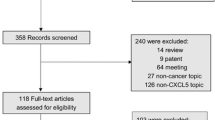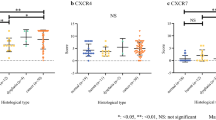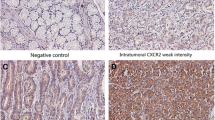Abstract
Background
CX3CL1 is a member of the chemokine family, and its receptor, CX3CR1, is expressed in pancreatic ductal adenocarcinoma. However, it is unclear whether there is a correlation between the expression of CX3CL1/CX3CR1 axis and the prognosis of patients with pancreatic ductal adenocarcinoma.
Methods
Tissue microarray and immunohistochemistry were used to study the expression of CX3CL1 and CX3CR1 in 105 specimens of pancreatic ductal adenocarcinoma. We analyzed a relationship between patients’ clinicopathological parameters and overall survival to the expression level of the CX3CL1/CX3CR1 axis using standard statistical analysis.
Results
The expression of CX3CL1 and CX3CR1 (77.1 and 66.7 %, respectively) was clearly increased in areas of malignancy compared with peritumoral areas. We did not find any correlation between CX3CL1 and CX3CR1 expression with clinical or pathological data. Patients’ overall survival was clearly worse with the combined high expression of CX3CL1 and CX3CR1. Patients with a high CX3CL1 expression tumor had a significantly shorter overall survival. High CX3CR1 expression was an independent negative prognosis factor.
Conclusion
We propose that the expression level of CX3CL1/CX3CR1 axis could provide clinical prognostic value, and the next steps should be to further investigate the mechanism by which CX3CL1 and its receptor impact survival in pancreatic ductal adenocarcinoma.


Similar content being viewed by others
References
Jemal A, Siegel R, Ward E, Murray T, Xu J, Thun MJ. Cancer statistics. 2007. CA Cancer J Clin. 2007; 57: 43–66.
Lillemoe KD, Yeo CJ, Cameron JL. Pancreatic cancer: State-of-the-art care. CA Cancer J Clin 2000; 50: 241-268.
Kleeff J, Friess H. Nonmetastatic pancreatic cancer: Many trials, little progress. J Clin Oncol. 2008; 26: 3100; author reply 3100–3101.
Bazan JF, Bacon KB, Hardiman G, Wang W, Soo K, Rossi D, Greaves DR, Zlotnik A, Schall TJ. A new class of membrane-bound chemokine with a CX3C motif. Nature. 1997; 385: 640–644.
Pan Y, Lloyd C, Zhou H, Dolich S, Deeds J, Gonzalo JA, Vath J, Gosselin M, Ma J, Dussault B, Woolf E, Alperin G, Culpepper J, Gutierrez-Ramos JC, Gearing D. Neurotactin, a membraneanchored chemokine upregulated in brain inflammation. Nature. 1997; 387: 611–617.
Imai T, Hieshima K, Haskell C, Baba M, Nagira M, Nishimura M, Kakizaki M, Takagi S, Nomiyama H, Schall TJ, Yoshie O. Identification and molecular characterization of fractalkine receptor CX3CR1, which mediates both leukocyte migration and adhesion. Cell. 1997; 91: 521–530.
Premack BA, Schall TJ. Chemokine receptors: Gateways to inflammation and infection. Nat Med. 1996; 2: 1174–1178.
Rossi D, Zlotnik A. The biology of chemokines and their receptors. Annu Rev Immunol. 2000; 18: 217–242.
Ohta M, Tanaka F, Yamaguchi H, Sadanaga N, Inoue H, Mori M. The high expression of Fractalkine results in a better prognosis for colorectal cancer patients. Int J Oncol. 2005; 26: 41–47.
Shulby SA, Dolloff NG, Stearns ME, Meucci O, Fatatis A. CX3CR1-fractalkine expression regulates cellular mechanisms involved in adhesion, migration, and survival of human prostate cancer cells. Cancer Res. 2004; 64: 4693–4698.
Hyakudomi M, Matsubara T, Hyakudomi R, Yamamoto T, Kinugasa S, Yamanoi A, Maruyama R, Tanaka T. Increased expression of fractalkine is correlated with a better prognosis and an increased number of both CD8+ T cells and natural killer cells in gastric adenocarcinoma. Ann Surg Oncol. 2008; 15: 1775–1782.
Marchesi F, Piemonti L, Fedele G, Destro A, Roncalli M, Albarello L, Doglioni C, Anselmo A, Doni A, Bianchi P, Laghi L, Malesci A, Cervo L, Malosio M, Reni M,Zerbi A, Di Carlo V, Mantovani A, Allavena P. The chemokine receptor CX3CR1 is involved in the neural tropism and malignant behavior of pancreatic ductal adenocarcinoma. Cancer Res. 2008; 68: 9060–9069.
D'Haese JG, Demir IE, Friess H, Ceyhan GO. Fractalkine/CX3CR1: Why a single chemokine-receptor duo bears a major and unique therapeutic potential. Expert Opin Ther Targets. 2010; 14: 207–219.
Hatori K, Nagai A, Heisel R, Ryu JK, Kim SU. Fractalkine and fractalkine receptors in human neurons and glial cells. J Neurosci Res. 2002; 69: 418–426.
Cardona AE, Pioro EP, Sasse ME, Kostenko V, Cardona SM, Dijkstra IM, Huang D, Kidd G, Dombrowski S, Dutta R, Lee JC, Cook DN, Jung S, Lira SA, Littman DR, Ransohoff RM. Control of microglial neurotoxicity by the fractalkine receptor. Nat Neurosci. 2006; 9: 917–924.
Matsubara T, Ono T, Yamanoi A, Tachibana M, Nagasue N. Fractalkine-CX3CR1 axis regulates tumor cell cycle and deteriorates prognosis after radical resection for hepatocellular carcinoma. J Surg Oncol. 2007; 95: 241–249..
Andre F, Cabioglu N, Assi H, Sabourin JC, Delaloge S, Sahin A, Broglio K, Spano JP, Combadiere C, Bucana C, Soria JC, Cristofanilli M. Expression of chemokine receptors predicts the site of metastatic relapse in patients with axillary node positive primary breast cancer. Ann Oncol. 2006; 17: 945–951.
Harnden P, Shelley MD, Clements H, Coles B, Tyndale-Biscoe RS, Naylor B, Mason MD. The prognostic significance of perineural invasion in prostatic cancer biopsies: A systematic review. Cancer. 2007; 109: 13–24.
Liebig C, Ayala G, Wilks JA, Berger DH, Albo D. Perineural invasion in cancer: A review of the literature. Cancer. 2009; 115: 3379–3391.
Vrielinck LJ, Ostyn F, van Damme B, van den Bogaert W, Fossion E. The significance of perinerual spread in adenoid cystic carcinoma of the major and minor salivary glands. Int J Oral Maxillofac Surg. 1988; 17: 190-193.
Zhang S, Qi L, Li M, Zhang D, Xu S, Wang N, Sun B. Chemokine CXCL12 and its receptor CXCR4 expression are associated with perineural invasion of prostate cancer. J Exp Clin Cancer Res. 2008; 27: 62.
Acknowledgments
We thank the patients who willingly and generously provided data and samples for research purposes and also appreciate the language polishing of Dr. Chaoling Yang and Dr. Shaunessy Rogers and the technical assistance of Ling Huang, Jun Lv, and Jingjing Xu.
Author information
Authors and Affiliations
Corresponding author
Additional information
Xianhui Xu and Yang Wang contributed equally to this paper and wrote the paper.
Rights and permissions
About this article
Cite this article
Xu, X., Wang, Y., Chen, J. et al. High Expression of CX3CL1/CX3CR1 Axis Predicts a Poor Prognosis of Pancreatic Ductal Adenocarcinoma. J Gastrointest Surg 16, 1493–1498 (2012). https://doi.org/10.1007/s11605-012-1921-7
Received:
Accepted:
Published:
Issue Date:
DOI: https://doi.org/10.1007/s11605-012-1921-7




